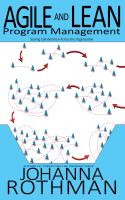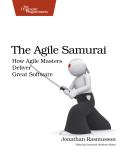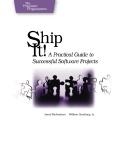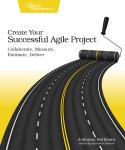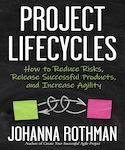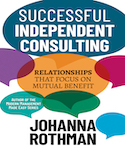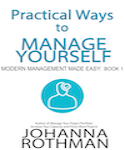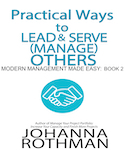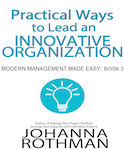About This Title
Pages:
Published: July 2019
ISBN: pending
In Print
Create Your Successful Agile Project (audio book)
by Johanna Rothman
You think agile techniques might be for you, but your projects and organization are unique. An “out-of-the-box” agile approach won’t work. Instead, unite agile and lean principles for your project. See how to design a custom approach, reap the benefits of collaboration, and deliver value. For project managers who want to use agile techniques, managers who want to start, and technical leaders who want to know more and succeed, this book is your first step toward agile project success.
Includes audiobook in m4b and mp3 formats.
Get the ebook version.
Buy the audiobook here for $19.99 Available in mp3, m4b, and ogg formats except as noted.
You’ve tried to use an off-the-shelf approach to agile techniques, and it’s not working. Instead of a standard method or framework, work from agile and lean principles to design your own agile approach in a way that works for you. Build collaborative, cross-functional teams. See how small batch sizes and frequent delivery create an environment of trust and transparency between the team, management, and customers. Learn about the interpersonal skills that help agile teams work together so well.
In addition to seeing work and knowing what “done” means, you’ll see examples of many possible team-based measurements. Look at tools you can use for status reporting, and how to use those measurements to help your managers understand what agile techniques buy them. Recognize the traps that prevent agile principles from working in too many organizations, and what to do about those traps. Use agile techniques for workgroups, and see what managers can do to create and nurture an agile culture. You might be surprised at how few meetings and rituals you need to still work in an agile way.
Johanna’s signature frankness and humor will get you on the right track to design your agile project to succeed.
What You Need
Resources
Releases:
Contents & Extracts
- Introduction
- Why Agile and Lean Approaches Work
- Software, We Have a Problem
- Agile Is a Cultural Change
- The Twelve Principles of Agile Software Development
- The Two Pillars of Lean
- Iteration- and Flow-Based Agile
- Integrate the Agile and Lean Principles
- Now Try This
- Why Agile and Lean Approaches Work
- Create a Successful Agile Team
- Build the Cross-Functional, Collaborative Team
- The Project Team Is a Product-Development Team
- Agile Changes Team Roles
- Team Size Matters
- Ask Teams to Organize Themselves
- Facilitate the Team’s Social Contract
- Agile Teams Become Self-Organizing
- Keep Teams Together
- Recognize Team Traps
- Now Try This
- Build Teamwork with Interpersonal Practices
- How Agile Team Members Are Similar
- Team Members Practice Continual Feedback
- Team Members Coach Each Other
- Recognize When the Team Needs an External Coach
- Does the Team Need to Track Collaboration?
- Help the Team Members Build Trust
- Create a Team Environment of Safety
- Recognize Interpersonal-Skills Traps
- Now Try This
- Agile Requires Different Project Leadership
- How Leaders Serve the Team
- Agile Project Managers Facilitate to Serve
- What Product Owners Do
- How Roles Change in Agile Projects
- Consider Your Team’s Need for Management
- Recognize Leadership Traps
- Now Try This
- Build the Cross-Functional, Collaborative Team
- Design and Manage an Agile and Lean Project
- Start Your Agile Project Right
- Charter Your Project
- Identify Your Product Type
- Assess Your Project’s Risks
- Start Architecture Thinking
- Recognize Project-Startup Traps
- Now Try This
- Teams Deliver Features
- Plan at Several Levels
- Release for Learning, Feedback, and Value
- Deliver Value Through the Architecture
- Create a Walking Skeleton
- Deliver Value to Someone by Using Features
- Define Stories So You Can See the Value
- Experiment and Spike to Explore
- Write Small Stories
- Create Rolling-Wave Roadmaps
- Use a Feature Parking Lot to See Possibilities
- Consider Minimum Viable Products and Experiments
- Recognize Value Traps
- Now Try This
- Rank the Work
- Rank the Shortest Work First
- Use Cost of Delay to See Value
- Rank by Valuing the Learning
- Recognize Ranking Traps
- Now Try This
- Visualize Your Work with a Board
- Start with a Paper Board
- Iteration-Based Boards Show Team Commitments
- Kanban Boards Show Team Flow and Bottlenecks
- Make Your Own Board
- Visualize Problems with a Board
- Create Visible Boards for Geographically Distributed Teams
- Recognize Visualization Traps
- Now Try This
- Create Technical Excellence
- How Much “Quality” Does Your Product Need?
- Integrate as Often as Possible
- Consider Continuous Delivery
- Refactor Every Time You Touch Code or Tests
- Work as a Whole Team to Create the Product
- Test at All Levels So Change Is Easy
- Beware of Technical Debt and Cruft
- Work at a Sustainable Pace
- Use Technical Excellence to Speed Development
- Recognize Excellence Traps
- Now Try This
- Agile Estimation: The Good, The Bad, and The Ugly
- Understand Velocity
- Learn to Estimate with Relative Sizing
- Use Relative Estimation for Iteration-Based Estimates
- Count Stories Instead of Points
- Consider Cycle Time to Create More Accurate Estimates
- Know the Purpose of Your Estimation
- Create Approximate Estimates for Management
- Estimate Support Work
- Use Previous Data to Inform Your Next Estimate
- Consider the Value of #NoEstimates in Your Organization
- Recognize Estimation Traps
- Now Try This
- Know What “Done” Means
- See the Different Levels of Done
- Define Acceptance Criteria for Each Story
- Define What “Done” Means as a Working Agreement
- Consider When You Can Release to Customers
- Understand When Customers Can Take Your Releases
- Building a Product Toward “Real” Doneness
- Recognize “Done” Traps
- Now Try This
- Agile Team Measurements
- Teams Learn from Their Measurements
- Understand Burndowns and Burnups
- Burnups Show You the Rate of Finishing
- Iteration Contents Show What the Team Completed
- Cumulative Flow Shows Where the Work Is
- Cycle Time Shows How Long Work Takes
- Velocity Is a Capacity Measurement
excerpt

- Agile Approaches Change the Meaning of Defect Measurements
- Recognize Team-Measurement Traps
- Now Try This
- Help Your Meetings Provide Value
- Retrospectives Provide Valuable Data
- Walk the Board
- Standups Create Recommitment and Collaboration
- Solve Problems Outside of Standups
- Demonstrations Show Progress and Value
- Plan the Backlog
- Create or Refine the Stories as Preparation for Future Work
- Organize the Team’s Meetings
- Measure the Value from Meetings
- Create Learning Opportunities
- Recognize Meeting Traps
- Now Try This
- Report Your Project State
- Show Working Product
- Show Feature Progress
- Show Other Requests in to the Team
- Show What’s Done but Not Yet Released
- Visualize Your Project’s Delays
- Measure the Effects of Delays
- Recognize Project-Measurement Traps
- Now Try This
- Start Your Agile Project Right
- Help Work Groups and Managers Use Agile
- Create an Agile Work Group
- Work Groups Meet Differently than Teams
- How Will the Group Visualize Its Work and Data?
- Visualize Work for a Management Team
- Product Development Is Cross-Functional
- Every Group Decides How and When to Reflect
- Now Try This
- How Managers Help Agile Teams
- Managers Resolve Impediments the Team Escalates
- Managers Help Create the Workspace Your Team Needs
- Managers Move from Resource-Efficiency to Flow-Efficiency Thinking
- Managers Help with Team-Based Recognition
- Avoid Management Mayhem
- Recognize How Managers Can Help Agile Teams
- Now Try This
- Start Somewhere
- Limit the Work in Progress
- Ask People to Work as a Cross-Functional Team
- Start with Yourself
- Last Thoughts
- Create an Agile Work Group
Author
Johanna Rothman, the “Pragmatic Manager,” offers frank, practical advice that you can immediately apply to your product development challenges.
She helps leaders and teams uncover effective alternatives to their current product development practices. Since one size never fits all, she works with her clients to explore options for what and how to change. The results? Leaders and teams learn to collaborate and focus on outcomes that matter.
With her trademark practicality and humor, Johanna is the author of 21 books, hundreds of articles, and thousands of blog posts about many aspects of management and product development. Find her monthly newsletter and blogs at jrothman.com and createadaptablelife.com.
Buy the audiobook here for $19.99 Available in mp3, m4b, and ogg formats except as noted.
Related Titles:
About This Title
Pages:
Published: July 2019
ISBN: pending
Edition: 1
In Print





